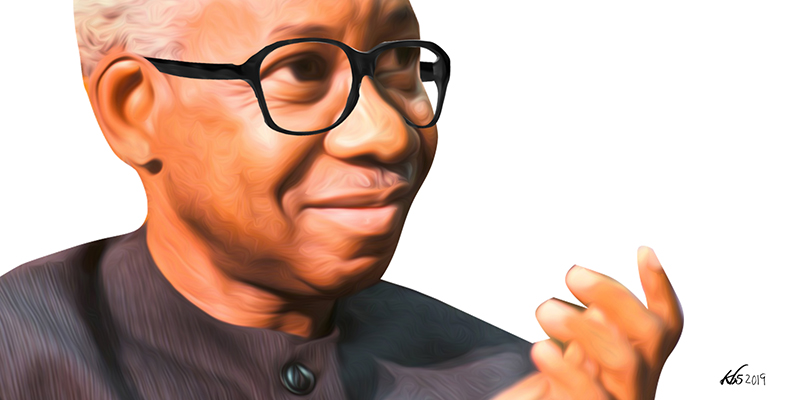On October 14, 2019, President John Pombe Magufuli officially moved his presidential operations to Dodoma, the capital city in the central region of Tanzania.
Was the move to Dodoma, which is 420 kilometres from Dar es Salaam, on the weekend preceding the 14th of October, a coincidence or a well-calibrated move? October 14th is the day that Mwalimu Julius Kambarage Nyerere, the first president of the Republic of Tanzania, died. In the wider scheme of things, it could as well have been both: President Magufuli, looking to be re-elected in a year’s time, may have made a deft tactical manoeuvre to signal his re-election bid in earnest.
Forty-six years ago, in 1973, Mwalimu Nyerere had picked Dodoma as the future capital city of the republic, citing its centrality and its ample, expansive and flat land as fit credentials for the new capital. Although, Mwalimu did not live to see the transfer of the capital, President Magufuli understands the import of fast-tracking the transfer of the presidential operations to Dodoma: Mwalimu would approve of it and the electorate would interpret the move as being in tandem with Mwalimu’s popular wish in a country currently in the grip of Mwalimu nostalgia. President Magufuli is probably riding on these feelings.
Keen Magufuli watchers have averred that he would very much like to be viewed as a Nyerereist, a man exemplifying the very (socialist) ideals of the post-colonial and independent Tanzania’s founding father. It has not been lost to observers that like Mwalimu, Magufuli considers and carries himself as a teacher: he was a chemistry tutor long before venturing into elective politics. In effect, Magufuli sees himself as the modern Tanzanian Mwalimu, the latter-day Nyerere, who would very much want to be loved in the same vein as Mwalimu.
But this article is not about President Magufuli – it is about Mwalimu Nyerere – who 20 years ago this month, exited the scene and the curtains fell on the 20th century’s arguably Africa’s greatest political leader. October commemorates Nyerere, particularly in Tanzania, and generally in the rest of the African continent. In recent times, there has been a debate in Tanzania, led by the likes of Pius Msekwa, the former Speaker of the National Assembly (1994–2005), whether to commemorate October 14, the day Nyerere died or April 13, 1922, his date of birth. Msekwa posits that April 13 should be made a holiday in Tanzania.
The spirit that calls rain
Mwalimu Julius Kambarage (the spirit that calls rain) Nyerere was born 97 years ago to his father Nyerere Burito (1860-1942) and his beloved mother Mugaya, who was the 18th wife of Burito, the paramount chief of the tiny Zanaki tribe. He was named after a rain spirit – Kambarage – because he was born during a storm. And the name Nyerere commemorated a plague of armyworms that struck the time of his father’s birth in 1862. Largely brought up by his mother, Nyerere converted to Catholicism at the age of 21and for the rest of his life, he would lead a Catholic life in deeds and words.
For a man whose relatives routinely lived past 90 years, Mwalimu “died young” in 1999 at the age of 77. Indeed, according to Nyerere himself, he was “a child” in the eyes of his chiefly clan: “In my clan, when your parents are still alive, you’re a child,” Nyerere remarked when he took a corpus of media personalities to the bedroom of his mother in Butiama, who had lived past 100 years. Nyerere came from a clan with the “gene of longevity”. His brother Wanzagi lived up to 86 years, his maternal uncle died as the age of 96, and his father’s brother (in African lingua, his elder father), died at the age of 95.
Mwalimu Julius Kambarage (the spirit that calls rain) Nyerere was born 97 years ago to his father Nyerere Burito (1860-1942) and his beloved mother Mugaya, who was the 18th wife of Burito, the paramount chief of the tiny Zanaki tribe. He was named after a rain spirit – Kambarage – because he was born during a storm.
Once, while campaigning for Benjamin William Mkapa, the Chama Cha Mapinduzi (CCM) candidate in the first multiparty elections in 1995, Nyerere had boasted that he would still be around in 2005 – in time for the third multiparty elections. But four years later, he was diagnosed with leukaemia at St Thomas Hospital in London, where he remarked to his close family members who had kept vigil at his bed, “I know I won’t live for long because I’m suffering from a terminal disease. I know Tanzanians are going to miss me, I’ll miss them too and I’ll pray for them once I depart for the hereafter world.”
Disillusionment with the party he founded
A founding member of CCM in 1977, a party he chaired till September 1991, Nyerere would later become so disillusioned with CCM apparatchiks that in early 1995, in a fit of anger, he proclaimed: “CCM is not my mother, I can leave it.” Whether the reference to his mother was coincidental or intentional is probably neither here nor there, but by the time he was uttering this statement, his mother was still alive and was exerting a strong influence on her former president son’s life.
Then to show his great disenchantment, he openly rebuked the party leaders, including President Ali Hassan Mwinyi, who he termed as a “weak person who is easily swayed”. In the last booklet that Nyerere penned – Uongozi Wetu Na Hatima ya Tanzania (Our Leadership and the Fate of Tanzania), he referred to Mwinyi as a “weakling”.
Really miffed by the happenings at CCM, Tanzanians saw a side of Nyerere that they had not witnessed. When Augustine Lyatonga Mrema, the then flamboyant Minister of Home Affairs, Labour and Youth Development, quit CCM in a huff to join the nascent opposition, Nyerere publicly defended him and reproached the CCM.
A month before the first multiparty elections in November, 1995, Nyerere proclaimed: “I cannot let the country go to the dogs.” Even when he was no longer at the epicentre of power, he ensured that the pendulum of power swung according to his wishes.
In 1995, the year of the first multiparty elections in Tanzania, Nyerere was applauded for the first time since retiring as president in 1984 for castigating a government that he believed had taken to alienating itself from the people. He launched his onslaught on CCM leaders’ misdemeanours, which he said were contrary to the party’s policies. Nyerere was so popular that had he wanted to have a go at the presidency, again, he would have rode home on a triumphant note.
In that year, Nyerere single-handedly picked his political protégé Benjamin Mkapa, the then Minister for Higher Education, Science and Technology, and campaigned for him across the country as the CCM’s flag bearer. With Nyerere’s backing, Mkapa, who once edited the government-owned newspaper the Daily News and its sister paper Sunday News, overcame the opposition to win the presidency. Nyerere, aware of the infighting within CCM, had deftly picked Mkapa, an intellectual who then had an unblemished record in the civil service and parliament, to assuage the feelings of his contemporaries in the party.
Who were some of his contemporaries? Edward Mrisho Lowassa, the then Minister of Lands and Urban Development and Jakaya Mrisho Kikwete, a former army officer and who would become the Minister of Foreign Affairs and Minister of Finance.
A month before the first multiparty elections in November, 1995, Nyerere proclaimed: “I cannot let the country go to the dogs.” Even when he was no longer at the epicentre of power, he ensured that the pendulum of power swung according to his wishes.
Lowassa in 1995 was 43 years old and rich. At the CCM national committee meeting in Dodoma, Nyerere asked a few unsavoury questions concerning Lowassa’s wealth. That sealed his fate. As for Kikwete, then 45, his religious affiliations must have worked against him in 1995. He is Muslim. Opposition to Mwinyi, a Muslim, had grown and Tanzanians in 1995 were reluctant to be led by another Muslim.
Nyerere had read the mood of the Tanzanians well: in selecting Mkapa as a compromise candidate in a field of 16 CCM party presidential candidates, he had appeased the party loyalists (wakereketwa), who had been disenchanted that Lowassa had not been picked by the party. More importantly, Nyerere not only picked a Christian, but a Catholic. Still, supporters of Tanzania’s multiparty system will always remember Nyerere as the man who paved the way for pluralistic politics in the country.
Once described by Prof Ali Mazrui, as a “heroic failure”, Nyerere remained the embodiment of Tanzanian politics, looming large over Tanzanians like a colossus. (Nyerere once praised Mazrui as a famous public intellectual and interlocutor. When they met, he is reported to have said, “Nasikia sifa tu” [I can only luxuriate in your fame].)
The theme of “heroism” in Nyerere’s life would recur later in life when the Tanzanian Catholic clergy would seek to venerate him for his “saintly” deeds.
Nyerere was famous by all means, famous in the style of Socrates’ words: Fame is the perfume of heroic deeds. A philosopher-king, Nyerere went further to perfect Socrates’ epigram – fame is the perfume of heroic deeds and spectacular failures. Nyerere failed spectacularly in some of his political experiments.
The Arusha Declaration and its aftermath
In October 1995, one month before the general elections, I met Abdulrahman Mohamed Babu, the Zanzibari Marxist intellectual and former Minister of Economy of Tanzania, at the Gandhi Hall in Mwanza, the lakeshore town on the shores of Lake Victoria in western Tanzania. “Anybody who wants to understand Nyerere must begin first by demystifying him,” said Babu in his introductory remarks.
For the 23 years that he was in power, said Babu, Nyerere shaped and reshaped the destiny of a nation with the single-mindedness of a chief, convinced that Tanzania’s fate lay in “African Socialism” – a concoction of scientific socialism and African communalism. So, in February 1967, Nyerere came up with a blueprint that Babu believed Nyerere wrote himself: Azimio la Arusha (The Arusha Declaration). And for the next two decades, the document’s philosophy formed the basis of Ujamaa (loosely translated as brotherhood). This led to the formation of rural collectives (Ujamaa villages) for agricultural production and the nationalisation of industries. The philosophy underplayed ethnicity and focused on unity. However, this radical experiment turned out to be a monumental failure. Till today, there is a section of Tanzanians who are rankled by those heady days of the disastrous Ujamaa policy.
In August 1984, Nyerere, who in his spare time had translated two of Shakespeare’s plays – Julius Caesar and Merchant of Venice – into Kiswahili, coined a new Kiswahili word: kungátuka, meaning to retire. And with that he left the Msasani State House that faced the Indian Ocean in Dar es Salaam.
Once referred to as a cunning fox by Deng Xiaoping, the Chinese supreme leader, Nyerere later shifted positions on kungátuka and said: “Sikungátuka…nimefanya kutoa guu.” I didn’t retire…I just relocated my foot.
I met Nyerere twice: once in a political meeting in Mwanza where, as master and servant politician, he was doing what he knew best: dazzling the crowd and mesmerising them with his magic wand. The second time was in a gathering of a graduating class, where again the philosopher-king was at ease, bantering away with the graduates and their professors alike. On both occasions, I got the impression that Nyerere was ever the king-maker, the philosopher-king, whose words everybody hung onto.
For the 23 years that he was in power, said Babu, Nyerere shaped and reshaped the destiny of a nation with the single-mindedness of a chief, convinced that Tanzania’s fate lay in “African Socialism” – a concoction of scientific socialism and African communalism.
Feted at home and abroad, Nyerere had the simplicity of the underclass and the power and gait of aristocracy. He exuded exceptional political morality and was celebrated in the West by the liberal left. He became the darling of left-leaning governments in Europe, such as Sweden, which poured donor aid into the country and held Nyerere up as an example of good African leadership. Mwalimu stood like a beacon of rationality, sobriety and princely leadership. In essence, Mwalimu was an institution unto himself. Sometimes referred to as the “peasant-president”, Nyerere had the privileges of a royal prince who found himself among real peasants who could only marvel at his power and grandeur.
As part of the crop of post-colonial African leaders who emerged in the 1950s, Nyerere carried with him huge dreams – oftentimes huger dreams than he could find time to interpret in his lifetime. Sometimes in the process of interpreting those dreams, he got carried away and possessed by them and anybody who did not dream along, or proffered a different interpretation, found himself at a crossroads and at odds with the mighty Mwalimu.
For instance, when cabinet minister Oscar Kambona disagreed with some of the tenets of the Arusha Declaration, he found himself in exile. Babu, after being released from detention by Mwalimu, opted to live in exile as well, in the “cold climes of London”, as he used to refer to the harsh British climate. Even the Sykes brothers, who had been influential in founding the TANU party (which later morphed into CCM), and who had funded it and had even inviting Nyerere to join it in the mid-1950s, opted to stay put and gradually melt into political oblivion.
At a time when the institution of the presidency was synonymous with an individual and state-led development, we must give it to Nyerere for stepping aside (for whatever reason) and allowing his protégé to take over.
The Catholic president
Seven years after his death, the Tanzania Episcopal Conference (TEC), through the cooperation of the Musoma Diocese, opened a cause for Nyerere’s beatification with the approval of the Vatican. The Catholic leadership of Tanzania throughout Nyerere’s reign loved him: the Catholic church was the only institution whose properties were not nationalised with the advent of the Arusha Declaration. The church continued to run its hospitals and schools, and to own its huge tracts of land without the state intervention.
After TEC’s proposition, an Italian, Silvia Cinzia Turrin, wrote an essay on Nyerere: Nyerere, il maestro. Vita e utopie di un padre del lÁfrica, Cristiano e socialista (Nyerere, the teacher. Life and utopia of an African priest, a Christian and socialist.)
The Catholic church in Tanzania, with the tacit approval of the Maryknoll Fathers, and the American missionary group that first went to Tanzania as White Fathers at the beginning of the 20th century, and who ran Musoma diocese, spoke of Nyerere’s heroism within the Catholic church. They argued that Nyerere was fit for canonisation because of his saintly deeds. While Prof Mazrui saw Nyerere as a heroic failure, the Catholic church in Tanzania saw Nyerere as the exemplification of an ideal Catholic.
In the Catholic church, canonisation or sainthood is the church’s official recognition that the person so declared has performed heroic deeds (on earth) and is without doubt with God in heaven. Pastorally, it has an even greater significance; it means that the church has put forward the life of the person in question as an example for all Catholic faithfuls to follow during their pilgrimage towards the final vision of God at death – the beatification. Nyerere’s beatification is currently one of the 44 pending cases from the African continent.
Nyerere’s success as a president who ably balanced his religious creed and political beliefs has been celebrated all over the world. He is seen as a leader who astutely preached religious co-existence, harmony and tolerance. Many may be taken aback and may not remember that the Republic of Tanzania, alongside the islands of Pemba and Zanzibar, in a manner of speaking, is largely a “Muslim” country, even though Catholicism is the biggest Christian denomination.
Was Nyerere, therefore, the Catholic president of a Muslim country? For all the years that Nyerere was the president of Tanzania, he never preached Catholicism to Tanzanians, even though he led a very devout Catholic life both privately and publicly.
The Catholic church in Tanzania, with the tacit approval of the Maryknoll Fathers, and the American missionary group that first went to Tanzania as White Fathers at the beginning of the 20th century, and who ran Musoma diocese, spoke of Nyerere’s heroism within the Catholic church. They argued that Nyerere was fit for canonisation because of his saintly deeds.
Nyerere is normally compared to another African “Catholic president” who reigned largely in a Muslim country – Senegal. Leopold Sedar Senghor, the African-French gentleman, practised his Catholicism in a country whose more than 80 per cent population obey Allah, but never, at any time, did the Senegalese feel that their president was biased towards Catholicism.
One year after Nyerere’s death, I posed the question: Between Nelson Mandela, the Black Pimpernel and Mwalimu Nyerere, who was the fairest? Then, as now, I believe Madiba might as well arguably turn out to be Africa’s best leader-president of all time. So, while Nyerere will forever remain great (partly because of making great mistakes), Mandela will forever be remembered for spending a third of his life in South African prisons and surviving to assume the presidency of a Rainbow Nation.
***
In November 2000, I was in Dar es Salaam to cover the second multiparty elections. It was the first election that was being held in the absence of the towering Mwalimu. The violence that was meted on the opposition party, the Civic United Front (CUF), CCM’s bitterest rival, was unprecedented. My Tanzanian colleagues and friends would later reminisce that had Nyerere been alive, little of that violence would have been witnessed.
Since Mwalimu’s death, Africa especially, has remained lonely without his presence. It is probable that the continent may not have another Nyerere for a long time. Yet it is now, in this momentous time in the world’s history, that Africa needs a Nyerere.








